The Cahuilla Homeland
The Cahuilla homeland in California was bounded on the north by the San Bernardino Mountains; on the south by the northern Borrego Desert; on the east by the Colorado Desert; on the west by the present-day city of Riverside. The designation Cahuilla is said to mean “masters” or “powerful ones.” As a tribal designation, Cahuilla is more of a linguistic designation than a governmental or political one: the many different Cahuilla villages tended to be autonomous and there was no single overall governmental structure which united them.
The map shown above shows the territories of the six Southern California Indian nations.
With regard to language, the Cahuilla language belongs to the Cupan subgroup of the Takic family of Uto-Aztecan languages. With regard to the geography of the Cahuilla homelands, Lowell John Bean, in his entry on the Cahuilla in The Handbook of North American Indians, writes:
“The Cahuilla area was topographically complex: mountain ranges interspersed by passes, canyons, valleys, and desert, with elevations from 11,000 feet in the San Bernardino Mountains to 273 feet below sea level at the Salton Sink.”
With regard to subsistence, the Cahuilla were primarily hunting and gathering people who raised some corn, beans, squash, and melons. They used about 200 different wild plants for food, fiber, and medicine.
The Cahuilla Continuum was an exhibit at the Riverside Metropolitan Museum authored and curated by Sean C. Milanovich. The exhibit told the story of the Cahuilla from creation to the present day. One display in the exhibit focused on témal (land). According to this exhibit:
“The Cahuilla have created a home for themselves in the northwest extension of the Sonoran Desert and have been there for as long as they can remember. Cahuilla territory traverses across the desert floor to steep mountains. The San Jacinto Mountains to the west, the Little San Bernardino Mountains to the north and Santa Rosa Mountains to the south surround the area.”
 Shown above is a basket tray (kávashmal) made in the early twentieth century. This unusually deep basket features plant designs.
Shown above is a basket tray (kávashmal) made in the early twentieth century. This unusually deep basket features plant designs.  Shown above is a basket bowl (kávamal) made in the early twentieth century. This basket features a large leaf or blossom design.
Shown above is a basket bowl (kávamal) made in the early twentieth century. This basket features a large leaf or blossom design.  Shown above is a small basket (ínishily) made before 1910 on the Soboba Reservation. This small oval bowl features a plant design.
Shown above is a small basket (ínishily) made before 1910 on the Soboba Reservation. This small oval bowl features a plant design.  Shown above is a basket bowl (kávamal) made about 1900. The blossom design represents the mequite blossom.
Shown above is a basket bowl (kávamal) made about 1900. The blossom design represents the mequite blossom.  Shown above is a gathering basket (sáqwaval) made about 1900. It features large eagles on the sides of the basket and a whirlwind pattern on its base.
Shown above is a gathering basket (sáqwaval) made about 1900. It features large eagles on the sides of the basket and a whirlwind pattern on its base.  Shown above is a gathering basket (sáqwaval) made about 1900 on the Soboba Reservation. It features a joined diamond pattern.
Shown above is a gathering basket (sáqwaval) made about 1900 on the Soboba Reservation. It features a joined diamond pattern.  Shown above is another view of the sáqwaval with the joined diamond pattern.
Shown above is another view of the sáqwaval with the joined diamond pattern.  Shown above is a basket bowl (kávamal) made about 1900.
Shown above is a basket bowl (kávamal) made about 1900.  Shown above is a basket bowl (kávamal) made by Antonia Apapas Casero on the Cahuilla Reservation about 1930.
Shown above is a basket bowl (kávamal) made by Antonia Apapas Casero on the Cahuilla Reservation about 1930.





